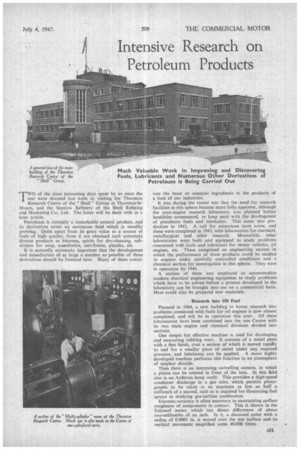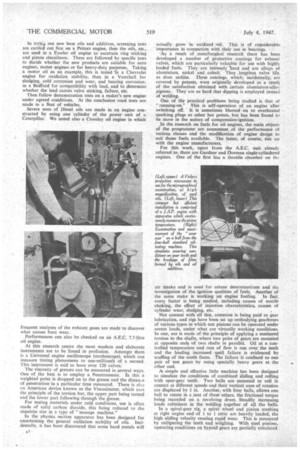Intensive Research on Petroleum Products
Page 33

Page 34

If you've noticed an error in this article please click here to report it so we can fix it.
TWO of the most interesting days spent by us since the war were devoted last week to visiting the Thornton Research Centre of the " Shell " Group at Thornton-leMoors, and the Stanlow Refinery of the Shell Refining and Marketing Co., Ltd. The latter will be dealt with in a later article.
Petroleum is certainly a remarkable natural product, and its derivatives cover an enormous field which is steadily growing. Quite apart from its great value as a source of fuels of high quality, from it are obtained such extremely diverse products as bitumen, spirits for dry-cleaning, substitutes for soap, anesthetics, anti-freeze, plastics, etc. If is naturally extremely important that the development and manufacture of as large a number as possible of these derivatives should be fostered here. Many of them consti tute the basic or essential ingredients in the products of a host of our industries.
It was during the recent war that the need for research facilities in this sphere became more fully.apparent, although the aero-engine research laboratory was planned before hostilities commenced, to keep pace with the development of petroleum fuels and lubricants. This came into production in 1942. A call for extensions soon arose, and these were completed in 1945, with laboratories for chemical, metallurgical and other research. Meanwhile, other laboratories were built and equipped to study problems concerned with fuels and lubricants for motor vehicles, oil engines, etc. These comprised an engineering section in which the performance of these products could be studied in engines under carefully controlled conditions and a chemical section for investigation in this sphere. "1 hey were in operation by 1944.
A section of them was employed to accommodate modern chemical engineering equipment to study problems which have to be solved before a process developed in the laboratory can be brought into use on a commercial basis. Here could also be prepared new materials.
Research into Oil Fuel Planned in 1944, a new building to house research into problems connected with fuels for oil engines is now almost completed, and will be in operation this year. All these laboratories have been combined into the one Centre with its two main engine and chemical divisions divided into sections.
One simple but effective machine is used for developing and measuring rubbing wear. It consists of a metal plate with a fine finish, over a section of which is moved rapidly to and fro a smaller piece of metal under any required pressure, and lubricants can be applied. A more highly developed machine performs this function in an atmosphere of sulphur dioxide.
Then there is an interesting swivelling camera, in which a piston can be rotated in front of the lens. In this field also is an Arditron lamp outfit. This provides a high-speed condenser discharge in a gas tube, which permits photographs to be taken at an exposure as low as half a millionth of a second, such as is required for illustrating fuel sprays in studying gas-turbine combustion. Extreme accuracy is often necessary in ascertaining surface roughness of components in contact. This is shown in the Talysurf meter, which can detect differences of about two-millionths of an inch. In it, a diamond point with a radius of 0.0001 in. is moved over the test surface and its vertical movement magnified some 40,000 times.
In tryir4 out new base oils and additives, screening tests are carried out first on a Petters engine, then the oils, etc., are used in a Fowler oil engine to ascertain ring sticking and piston cleanliness, These are followed by specific tests to decide whether the new products are suitable for aero engines, motor engines or for heavy-duty purposes. Taking a motor oil as an example, this is tested in a Chevrolet engine for oxidation stability, then in a Vauxhall for sludging, cold corrosion and wear, and bearing corrosion; in a Bedford for compatibility with lead, and to determine whether the lead causes valve sticking, failure, etc.
Then follow demonstration tests on a maker's new engine under agreed conditions. At the conclusion road tests are made in a fleet of vehicles.
Severe tests of Diesel oils are made in an engine constructed by using one cylinder of the power unit of a Caterpillar. We noted also a Crossley oil engine in which frequent analyses of the exhaust gases are made to discover what causes bore wear.
Performances can also be checked on an A.E.C. 7.7-litre oil engine.
At this research centre the most modern and elaborate instruments are to be found in profusion. Amongst them is a Universal engine oscilloscope (stroboscope), which can measure timing phenomena to one-millionth of a second. This instrument is said to have over 120 valves.
The viscosity of greases can be measured in several ways. One of the best is to employ a Penetrometer. In this a weighted point is dropped on to the grease and the distan.e. of penetration'in a particular time measured. There is al an American device known as the Viscosimeter, which uses the principle of the torsion bar, the upper part being turned and the lower part following through the grease.
For testing materials under cold conditions, use is often made of solid carbon dioxide, this being reduced to the requisite size in a type of "sausage machine." In the physics section apparatus has been designed for ascertaining the general oxidation stability of oils. Incidentally, it has been discovered that some hard metals will actually grow in oxidized nil. This is of copsiderable importance in connection with their use in bearings.
As a result of metallurgical research there has been developed a number of protective coatings for exhaust valves, which are particularly valuable for use with highly leaded fuels. They are intensely 'hard and are alloys of aluminium, nickel and cobalt. They lengthen valve life, as does stellite. These coatings, which, incidentally, are covered by patents, were originally developed as a result of the satisfaction obtained with certain aluminium-allo pistons. They are so hard that dipping is employed instead of welding.
One of the practical problems being studied is that of "running-on." This is self-operation of an engine after switching off. It is sometimes blamed on to overheated sparking plugs or other hot points, but has been found to be more in the nature of compression-ignition.
In the research on fuels for oil engines, the main objects of the programme are assessment ,of the performance ot various classes and the modification of engine design to suit those fuels available. The latter, of course, ties up with the engine manufacturers.
For this work, apart front the A.E.C. unit already referred to, there are Gardner and Dorman single-cylindered engines. One of the first has a throttle chamber on the
air intake and is used for cetane determinations and the investigation of the ignition qualities of fuels. Another of the same make is working on engine fouling. In fact, every factor is being studied, including causes of nozzle choking, the effect of injection characteristics, causes of cylinder wear, sludging, etc.
Not content with all this, attention is being paid to gear lubrication, and rigs have been set up embodying gearboxes of various types in which test pinions can be operated under severe loads, under what are virtually working conditions. In one, use is made of the principle of applying a measured torsion to the shafts, where two pairs of gears are mounted at opposite ends of two shafts in parallel. Oil at a controlled temperature and rate of flow is run over the teeth and the loading increased until failure is evidenced by scuffing of the tooth faces. The failure is confined to one pair of test gears by using specialty heavy gears at the other end.
At simple and effective little machine has been designed to simulate the conditions of combined sliding and rolling With spur-gear teeth. Two balls are mounted to roll in contact at different speeds and their vertical axes of rotation are displaced by in. Another, with four balls, allows one ball to rotate in a nest of three others, the frictional torque being recorded on a revolving drum. Steadily increasing loads culminate in the welding together of all the balls.
In a spiral-gear rig, a spiral wheel and pinion meshing at right angles and of 1 to 1 ratio are heavily loaded, the high sliding velocity causing rapid wear. This is measured by callipering the teeth and weighing. With steel pinions, operating conditions on hypoid gears are partially simulated.












































































